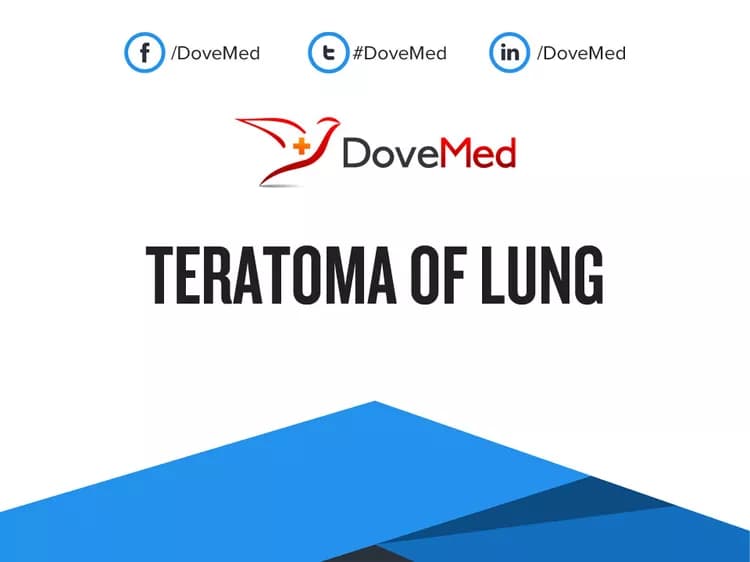What are the other Names for this Condition? (Also known as/Symptoms)
- Germ Cell Tumor of Lung - Teratoma
- Pulmonary Germ Cell Tumor - Teratoma
- Pulmonary Teratoma
What is Teratoma of Lung? (Definition/Background Information)
- A Teratoma of Lung is the most common type of germ cell tumor of the lung. However, the lung is a very uncommon site for such a tumor, and hence, the origin of the teratoma from other common sites (such as gonads) should be eliminated prior to establishing a diagnosis of primary Teratoma of Lung
- There are 2 main forms of Pulmonary Teratomas:
- Mature Teratoma of Lung: It is made up of cells that resemble adult tissue cells. Mature Teratoma of Lung can be completely (surgically) removed, because these cells do not typically spread to other body sites. However, there is some likelihood of reappearance after treatment
- Immature Teratoma of Lung: It is made up of cells that resemble an embryo, or developing fertilized egg. Immature teratoma is more likely than a mature teratoma to spread to other body sites. Thus, it is difficult to surgically remove them; they are also more likely to reappear after treatment
- Teratoma of Lung may be cancerous or benign. A majority of benign teratomas are mature teratomas, while a majority of malignant teratomas are immature teratomas
- Teratoma of Lung is typically seen in childhood and young adulthood. The cause of formation of this lung tumor is unknown. Also, presently the risk factors are not well-established
- The tumors may grow to large sizes and obstruct the lung airways. The presenting signs and symptoms may include shortness of breath, chest pain, and blood in sputum
- The treatment of Teratoma of Lung involves surgery. Immature teratomas may additionally be treated using chemotherapy and/or radiation therapy
- In a majority of cases, the prognosis of mature Teratoma of Lung is excellent with early appropriate treatment. However, the prognosis of immature Teratoma of Lung depends upon various factors and is usually poor
Notes on germ cells:
- Germ cells are one of the two types of cells in the body. They form sex cells - the sperms and eggs, while the other type, somatic cells, forms everything else (all other body organs and parts)
- Normal germ cells arise from pluripotent stem cells. Pluripotent stem cells can differentiate into, or become, any cell in the body. Thus, pluripotent stem cells may become either germ cells or somatic cells
- The process of pluripotent stem cells becoming other cell types is mediated by chemical signalling. Chemicals that act as signals include growth factors, nutrients, and hormones
- Stem cells that do not respond to normal signals may grow uncontrollably and cause tumors. This tumor-causing potential makes them “neoplastic”. Neoplastic cells that grow aggressively and spread to other areas are cancerous
Who gets Teratoma of Lung? (Age and Sex Distribution)
- Teratoma of Lung is a rare type of tumor that is mostly observed in older children and young adults; the peak age range is between 10-40 years
- However, infants, very young children, and older adults may also be affected. The overall age range is between 10 months to 68 years
- Both males and females are affected, although a slight preference for females is observed
- No specific racial or ethnic group predilection is noted
What are the Risk Factors for Teratoma of Lung? (Predisposing Factors)
- Currently, no definite risk factors have been identified for Teratoma of Lung
It is important to note that having a risk factor does not mean that one will get the condition. A risk factor increases ones chances of getting a condition compared to an individual without the risk factors. Some risk factors are more important than others.
Also, not having a risk factor does not mean that an individual will not get the condition. It is always important to discuss the effect of risk factors with your healthcare provider.
What are the Causes of Teratoma of Lung? (Etiology)
The cause of development of Teratoma of Lung is generally unknown.
- It is believed that abnormal differentiation of germ cells gives rise to cancerous cells that lead to the formation of this condition
- The tumor is thought to arise from abnormally-placed pharyngeal tissues (from the pharyngeal pouch or Zenker’s diverticulum); pharyngeal pouches are known to form during embryological development
What are the Signs and Symptoms of Teratoma of Lung?
The signs and symptoms of Teratoma of Lung may include the following:
- Presence of a well-circumscribed lesion in the upper lobes of the lung; mature teratomas are normally benign
- Cystic tumors may involve the airways/bronchus
- Immature teratomas are mostly solid and are known to be locally invasive
- The tumors may range in size from 3 to 30 cm
- The growth of the tumor mass may obstruct the airway
- Tumors affecting the bronchus can cause obstructive symptoms including chest pain, cough, breathing difficulties, and blood in sputum
- Trichoptysis: It is the most unusual and ‘specific’ sign of a teratoma, where the individual coughs-up hair or hair-like particles. This may occur from Pulmonary Teratomas or mediastinal teratomas (that has invaded the lung)
- When metastasis is noted, it may result in weight loss, fatigue, and other systemic symptoms
How is Teratoma of Lung Diagnosed?
There are a variety of tests the healthcare provider may employ to diagnose Teratoma of Lung, which may include:
- Physical examination and complete medical history screening: During the physical exam, the healthcare provider may listen to the lung with a stethoscope, to detect the presence of any abnormal lung sounds
- Imaging studies that may include a chest X-ray, MRI or CT scan of the lungs
- Arterial blood gases
- Lung function test
- Sputum cytology: This procedure involves the collection of mucus (sputum), coughed-up by the patient, which is then examined in a laboratory by a pathologist
A tissue biopsy refers to a medical procedure that involves the removal of cells or tissues, which are then examined by a pathologist. This can help establish a definitive diagnosis. The different biopsy procedures may include:
- Bronchoscopy: During bronchoscopy, a special medical instrument called a bronchoscope is inserted through the nose and into the lungs to collect small tissue samples. These samples are then examined by a pathologist, after the tissues are processed, in an anatomic pathology laboratory
- Thoracoscopy: During thoracoscopy, a surgical scalpel is used to make very tiny incisions into the chest wall. A medical instrument called a thoracoscope is then inserted into the chest, in order to examine and remove tissue from the chest wall, which are then examined further
- Thoracotomy: Thoracotomy is a surgical invasive procedure with special medical instruments to open-up the chest. This allows a physician to remove tissue from the chest wall or the surrounding lymph nodes of the lungs. A pathologist will then examine these samples under a microscope after processing the tissue in a laboratory
- Fine needle aspiration biopsy (FNAB): During fine needle aspiration biopsy, a device called a cannula is used to extract tissue or fluid from the lungs, or surrounding lymph nodes. These are then examined in an anatomic pathology laboratory, in order to determine any signs of abnormality. Nevertheless, FNAB is not a preferred method for the biopsy of lung tumors
- Autofluorescence bronchoscopy: It is a bronchoscopic procedure in which a bronchoscope is inserted through the nose and into the lungs and measure light from abnormal precancerous tissue. Samples are collected for further examination by a pathologist
Tissue biopsy from the affected lung:
- A biopsy of the tumor is performed and sent to a laboratory for a pathological examination. A pathologist examines the biopsy under a microscope. After putting together clinical findings, special studies on tissues (if needed) and with microscope findings, the pathologist arrives at a definitive diagnosis. Examination of the biopsy under a microscope by a pathologist is considered to be gold standard in arriving at a conclusive diagnosis
- Biopsy specimens are studied initially using Hematoxylin and Eosin staining. The pathologist then decides on additional studies depending on the clinical situation
- Sometimes, the pathologist may perform special studies, which may include immunohistochemical stains, molecular testing, flow cytometric analysis and very rarely, electron microscopic studies, to assist in the diagnosis
A differential diagnosis with respect to other lung cancer types may be necessary prior to establishing a definite diagnosis, by excluding the following cancers:
- Teratoma that has spread from other body sites
- Other pulmonary germ cell tumors
- Pulmonary hamartoma
- Glial heteropia affecting the lung (observed in children with neural tube defects)
Many clinical conditions may have similar signs and symptoms. Your healthcare provider may perform additional tests to rule out other clinical conditions to arrive at a definitive diagnosis.
What are the possible Complications of Teratoma of Lung?
The complications of Teratoma of Lung may include the following:
- Some immature teratomas are known to rupture and cause associated complications including bronchial or bronchopleural fistulas, lung inflammation, and fibrosis
- Severe obstruction of the airways in case of a large-sized tumor
- Metastasis of the immature or malignant teratoma to distant sites
- Recurrence of the tumor following its incomplete surgical removal: Immature forms are more often likely to recur than mature forms
There may be complications related to the methods used in treating the condition and may include:
- Side effects of radiation therapy that may include sunburn-like rashes, where radiation was targeted, red or dry skin, heaviness of the breasts, and general fatigue
- Side effects of chemotherapy, which may include nausea, vomiting, hair loss, decreased appetite, mouth sores, fatigue, low blood cell counts, and a higher chance of developing infections
- The treatment can also cause infertility in men and women. Hence, measures to protect the individual’s fertility must be considered, before starting chemotherapy
How is Teratoma of Lung Treated?
The treatment of Teratoma of Lung may involve the following:
- Generally, the treatment of choice is complete surgical excision for all teratomas (mature or immature)
- However, while it is usually possible to surgically remove a mature teratoma, the complete removal of an immature teratoma may be difficult
- Additionally, chemotherapy and/or radiation therapy may be necessary for malignant teratomas
- Follow-up care with regular screening and check-ups are important and encouraged
How can Teratoma of Lung be Prevented?
Currently, there are no known methods to prevent the development of Teratoma of Lung.
What is the Prognosis of Teratoma of Lung? (Outcomes/Resolutions)
- The prognosis of Teratoma of Lung depends upon whether it is a mature or immature type
- 4 out of 5 cases are mature teratomas that behave in a benign manner. With complete surgical removal of the tumor, the prognosis is typically excellent
- Immature teratomas are aggressive, difficult to treat (complete tumor resection may not be possible), and can spread to other sites. The prognosis of these tumors is usually poor; case studies indicate that the average survival following diagnosis in such cases is about 6 months
- If immature teratomas can be completely removed through surgery, then the prognosis is generally improved
Additional and Relevant Useful Information for Teratoma of Lung:
The following article link will help you understand other cancers and benign tumors:
Related Articles
Test Your Knowledge
Asked by users
Related Centers
Related Specialties
Related Physicians
Related Procedures
Related Resources
Join DoveHubs
and connect with fellow professionals


0 Comments
Please log in to post a comment.